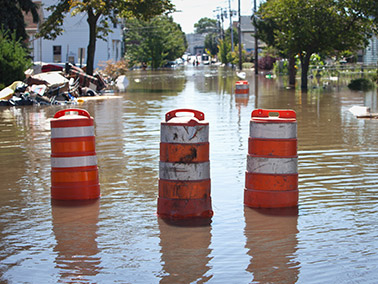The fact is it could happen to any of us. Here are some guidelines to keep in mind.
Know the risks
From earthquakes to tornadoes, a number of natural disasters can affect you depending on the region where you live. Every emergency is unique and needs to be handled differently, so you need to know what types of events are most likely to happen in your area, so you can prepare accordingly.
Make a plan
To be prepared—get an emergency plan. You can make your home emergency plan online, which guides you through the steps in about 20 minutes, or download Your Emergency Preparedness Guide and fill it out by hand.
Having a plan can help you:
- Identify emergency exits in your home and evacuation routes in your neighbourhood
- Establish a meeting place
- Plan who will pick up your children
- Make arrangements for your pets
- Plan for specific risks
- Address any special health needs
- Record emergency contact information, including for your insurance company
- Take steps to secure your home
Prepare an emergency kit
In case of a disaster, you should be prepared to take care of yourself and your family for a minimum of 72 hours. Your emergency kit should include these items:
- Water
- Food that won’t spoil
- Manual can-opener
- Flashlight and batteries
- Battery-powered or wind-up radio and extra batteries
- First aid kit
- Extra keys to your car and house
- Cash
- A copy of your emergency plan and contact information
- Special needs items such as prescription medication, infant formula, etc.
You can find a list of recommended additional items here or you can buy a pre-packaged kit from the Canadian Red Cross.
Returning to your home after a disaster
If you had to evacuate your home, you should only return after authorities tell you it’s safe to do so.
Before you go inside, check for visible damage to your roof, floors and foundation. If you suspect any kind of structural damage, do not enter your house.
Once you’re sure it’s safe for you to enter your home, follow these safety tips:
- Wear appropriate clothing and shoes (long pants, long-sleeved shirt, rubber boots and gloves).
- Use a flashlight. Don’t use the light switches.
- Never try to turn utilities back on until your local utility provider has checked them.
- Don’t try to use any electrical appliances or power that may have come in contact with fire or water.
- Check for exposed wires and avoid contact with damaged or fallen power lines and power poles.
- Follow any boil water advisories.
- Don’t throw anything away until you’ve contacted your insurance company.
- Take pictures and/or videos and make a list of damaged items.
- Don’t let children or pets play in the damaged areas.
- Throw away all perishable food items, including those in your freezer.
- Check the news for updates.
When returning home after a disaster, the precautions you should take will depend on the event. Remember that information centres will probably have been set up in your community, and you can always refer to them for more information. If you’re affected by a natural disaster, know that municipal and federal services, as well as major industry players are there to help.

